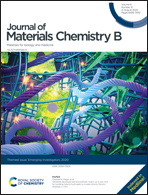Theranostics system caged in human serum albumin as a therapy for breast tumors†
Abstract
Biomimetic materials are attracting increasing attention in the field of drug delivery due to their low immunogenicity, good biocompatibility and degradability. Furthermore, the modification of endogenous species on the surfaces of biomimetic materials can generate new biomedical functions. A real-time understanding of the drug-release behavior, especially in vivo, can provide reliable information for drug activation and distribution. Herein, we describe a theranostics system caged in human serum albumin (HSA) as a therapy against breast tumors. The prodrug of a drug–dye conjugate (DDC) was successfully covalently linked into HSA via a disulfide-exchange reaction to give a high drug-loading rate. The drug-release and fluorescence recovery curves are in good agreement, allowing the drug-release kinetics to be monitored by a non-invasive fluorescence signal in real time. A disintegration mechanism triggered by GSH was suggested. The DDC@HSA particles show tumor-targeting capability, and good antitumor efficacy in vitro and in vivo. Hopefully, this strategy can provide a generalizable novel approach for the facile encapsulation of drugs for engaging HSA, paving the way for precision diagnosis and therapy in preclinical trials.

- This article is part of the themed collection: Journal of Materials Chemistry B Emerging Investigators


 Please wait while we load your content...
Please wait while we load your content...